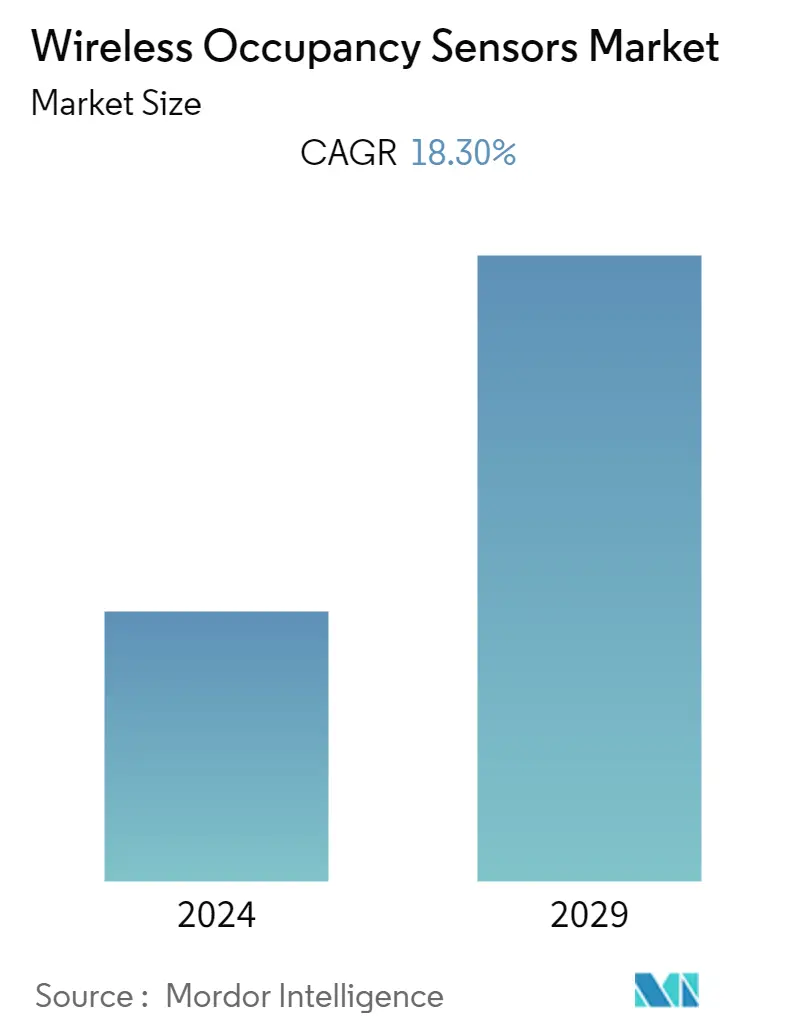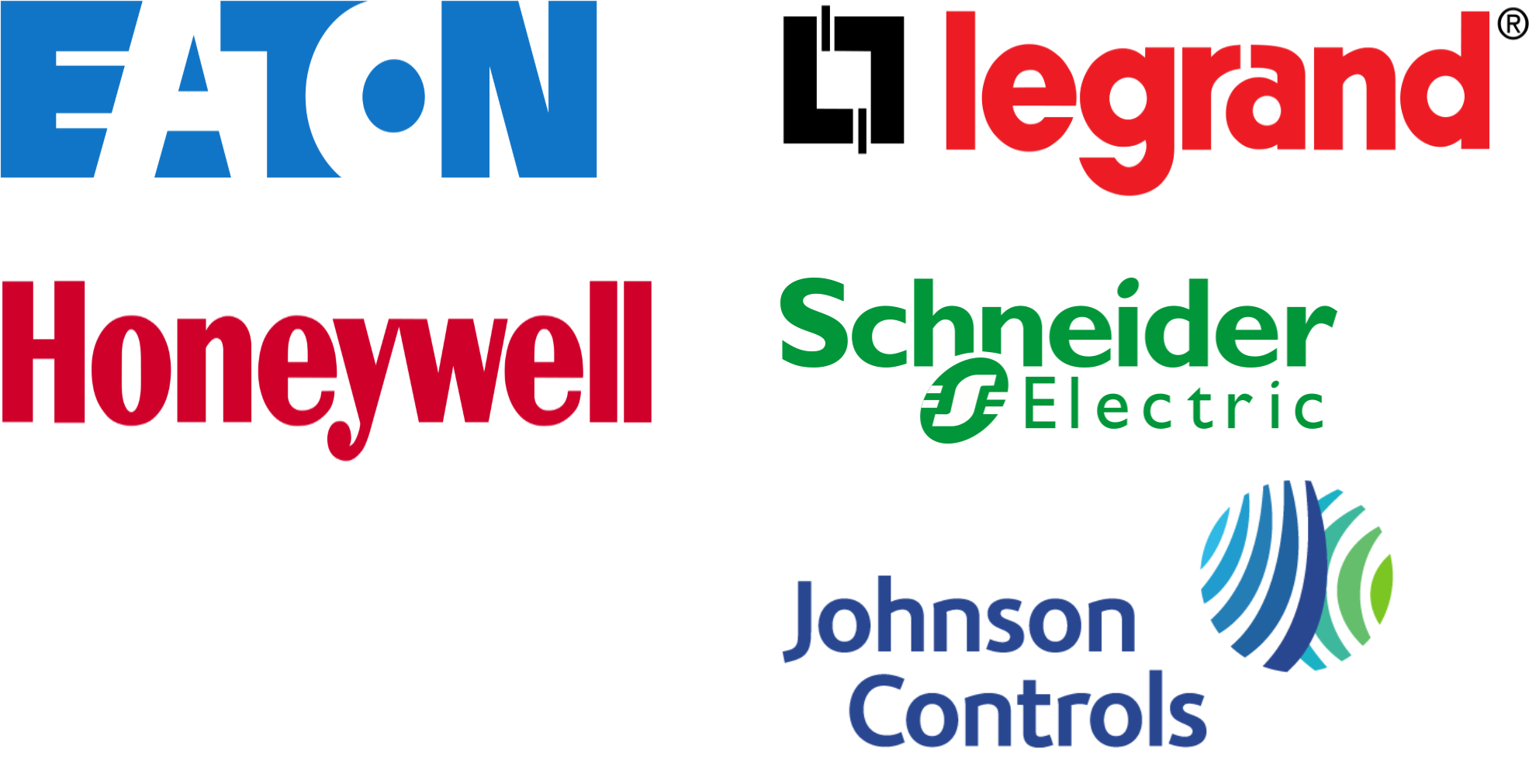Market Size of Wireless Occupancy Sensors Industry

| Study Period | 2019 - 2029 |
| Base Year For Estimation | 2023 |
| CAGR | 18.30 % |
| Fastest Growing Market | Asia Pacific |
| Largest Market | North America |
| Market Concentration | Low |
Major Players
*Disclaimer: Major Players sorted in no particular order |
Wireless Occupancy Sensors Market Analysis
The wireless occupancy sensors market is expected to register a CAGR of 18.3% over the forecast period (2021 - 2026). Energy-saving has been crucial for growth in any economy, as a result, the government is also coming with several policies to save energy, which will drive the market in the forecast period.
- The rising demand for energy-efficient devices is expected to drive the market. Wireless occupancy sensors play a vital role in reducing energy consumption. This is achieved through the sensors, which shuts down devices and other equipment on the basis of occupancy. These sensors help in reducing light pollution and they can be used for indoor and outdoor spaces.
- The demand for passive infrared is expected to continue in the future, due to the low cost, demand for energy-efficient devices, and less power requirement. It has a range of applications, such as lighting, spectrometers, gas, and fire detection systems, etc.
- Some of the major benefits of passive infrared sensors are accurate movement detection, reliable triggering, and cost-efficiency. Vending machine designers, for example, are now incorporating PIR sensors into their products so that their displays only light up when someone is standing in front of the unit or maybe waving their hand in front of a panel, which saves on operating costs.
- However, due to the false triggering of switch and inconsistency issues associated with wireless network system are anticipated to decrease the market growth during the forecast period.
Wireless Occupancy Sensors Industry Segmentation
Wireless occupancy sensors can be defined as a system that turns off and on the light automatically depending upon the vacancy. It also controls the temperature and ventilation systems. It helps in making life convenient and easier and also saves energy. Various sensors used are the infrared, ultrasonic, microwave. humidity, and temperature, other sensors.
| By Application | |
| Lighting Control | |
| HVAC | |
| Security Surveillance |
| By Building Type | |
| Residential Buildings | |
| Commercial Buildings |
| By End-user Industry | |
| Industrial | |
| Aerospace & Defence | |
| Healthcare | |
| Consumer Electronics | |
| Other End-user Industries |
| Geography | |||||||
| |||||||
| |||||||
| |||||||
| |||||||
|
Wireless Occupancy Sensors Market Size Summary
The wireless occupancy sensors market is poised for significant growth, driven by the increasing demand for energy-efficient devices and the global trend towards urbanization and smart city development. These sensors are crucial in reducing energy consumption by automating the shutdown of devices based on occupancy, thereby minimizing light pollution and enhancing energy savings. The market is further bolstered by the rising adoption of passive infrared sensors due to their cost-effectiveness and low power requirements, with applications spanning lighting, gas detection, and more. However, challenges such as false triggering and inconsistencies in wireless network systems may hinder market expansion. The integration of these sensors in smart city initiatives, such as intelligent parking systems and traffic management solutions, underscores their growing importance in urban environments.
In North America, the market is driven by innovations in occupancy sensor technology and the robust growth of the construction sector, particularly in residential and commercial buildings. The United States leads the market, supported by advancements in wireless network infrastructure and increased demand for HVAC systems. Key players in the market include Honeywell International, Schneider Electric, Eaton Corporation, and others, contributing to a fragmented competitive landscape. The introduction of innovative products, such as EnOcean's solar-powered Bluetooth occupancy sensor, highlights the ongoing technological advancements in the industry. As smart city projects continue to expand globally, the wireless occupancy sensors market is expected to experience sustained growth, supported by the need for efficient and sustainable urban solutions.
Wireless Occupancy Sensors Market Size - Table of Contents
-
1. MARKET DYNAMICS
-
1.1 Market Overview
-
1.2 Introduction to Market Drivers and Restraints
-
1.3 Market Drivers
-
1.3.1 Growing Demand for Green Energy
-
1.3.2 Growing Demmand for Easily Installable and Interoperable devices
-
-
1.4 Market Restraints
-
1.4.1 False Triggering of Switches
-
-
1.5 Industry Value Chain Analysis
-
1.6 Industry Attractiveness - Porter's Five Forces Analysis
-
1.6.1 Threat of New Entrants
-
1.6.2 Bargaining Power of Buyers/Consumers
-
1.6.3 Bargaining Power of Suppliers
-
1.6.4 Threat of Substitute Products
-
1.6.5 Intensity of Competitive Rivalry
-
-
-
2. MARKET SEGMENTATION
-
2.1 By Application
-
2.1.1 Lighting Control
-
2.1.2 HVAC
-
2.1.3 Security Surveillance
-
-
2.2 By Building Type
-
2.2.1 Residential Buildings
-
2.2.2 Commercial Buildings
-
-
2.3 By End-user Industry
-
2.3.1 Industrial
-
2.3.2 Aerospace & Defence
-
2.3.3 Healthcare
-
2.3.4 Consumer Electronics
-
2.3.5 Other End-user Industries
-
-
2.4 Geography
-
2.4.1 North America
-
2.4.1.1 United States
-
2.4.1.2 Canada
-
-
2.4.2 Europe
-
2.4.2.1 United Kingdom
-
2.4.2.2 France
-
2.4.2.3 Germany
-
2.4.2.4 Russia
-
2.4.2.5 Rest of Europe
-
-
2.4.3 Asia-Pacific
-
2.4.3.1 China
-
2.4.3.2 Japan
-
2.4.3.3 India
-
2.4.3.4 Rest of Asia-Pacific
-
-
2.4.4 Latin America
-
2.4.4.1 Brazil
-
2.4.4.2 Argentina
-
2.4.4.3 Maxico
-
2.4.4.4 Rest of Latin America
-
-
2.4.5 Middle East & Africa
-
2.4.5.1 Saudi Arabia
-
2.4.5.2 United Arab Emirates
-
2.4.5.3 South Africa
-
2.4.5.4 Rest of Middle East & Africa
-
-
-
Wireless Occupancy Sensors Market Size FAQs
What is the current Wireless Occupancy Sensors Market size?
The Wireless Occupancy Sensors Market is projected to register a CAGR of 18.30% during the forecast period (2024-2029)
Who are the key players in Wireless Occupancy Sensors Market?
Honeywell International, Eaton Corporation, Legrand Inc., Schneider Electric SE and Johnson Controls are the major companies operating in the Wireless Occupancy Sensors Market.

